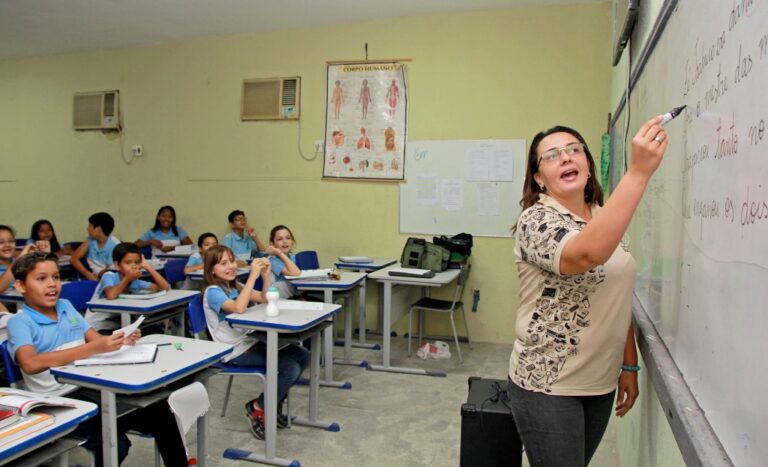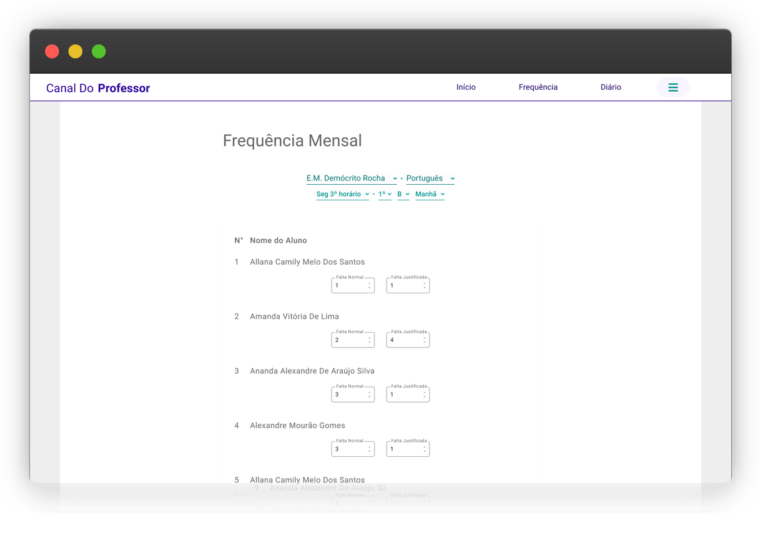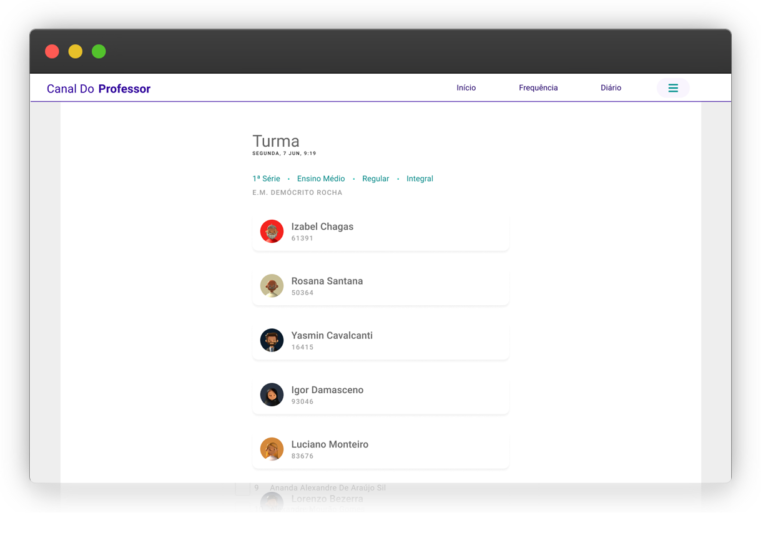Teacher´s Channel
It is a virtual agenda with the function of helping elementary school teachers from public schools in the city of Fortaleza to record attendance, grades, and lesson plans, because currently the records are made in physical agendas.
This was my end-of-course project in Systems Analysis and Development. It was developed in a team of 6 students and lasted 2 years.

Overview
For the final project of the ADS course, the students were required to form a team to create software for WEB and application platforms that would preferably help society. During the whole process until completion its scope needed to be reduced and we had to deal with changes in the team, despite the problems we managed to deliver a great product.
In this project I was able to take my first steps into the technology field and developing the following skills:
I studied the problem, researched and interviewed teachers and a secretary at a public school in Fortaleza to understand their pain points and create relevant requirements for creating a well-structured scope.
I learned to lead the team for a semester, to divide its functions, its weekly deliveries and always analyzing if the requirements were being applied.
I was responsible for creating and presenting what we developed weekly to the teachers as well as the final PITCH at the end of the semester.
The Process
Our process was based on the agile methodology. But previously we did desk research and UX techniques that will be detailed below.
Understanding the problem
Our team, after researching relevant problems, decided to use a personal problem of two members of our own team who worked as teachers in public schools in the municipal network of Fortaleza.
For years they worked recording grades, frequencies, and lesson plans in physical agendas, none of the process was digital, so they lost time and had more work to do to keep the agendas in order, because the city government does not provide teachers with access to the school system.
Thus, analyzing their pain with the other teachers in the municipal network, we saw that this problem would be important for our final work.
From that I did some research:
- You want to be more productive at work, practicality, modernize tools for controlling your records.
- What would be the main functions that our software should offer.
- Always align with the team if the requirements were being followed according to how a municipal public school management works.
gathering information
The first step, which was to know what was the problem we were going to solve, was completed, but we needed to have an overview of how we could work on our project, so I started Desk Research and analyzed government sites, news, and similar products on the market.
The result of this research was a CSD matrix that gave us questions to be answered in interviews.During the days that I worked at the school I talked with teachers and coordinators to understand how technology could help with school management and teacher records.
From the information we gathered we were able to create a persona that would represent a common profile of the school’s female teachers.
- Married, 28 years old.
- Organized, Methodical, Friendly and Outgoing
- You want to have more productivity at work, practicality, modernization tools to control your records.
Common scenario of the actions the teacher takes at school is:
- Record student attendance.
- Record lesson content.
- Record activity scores.
- Record work delivery.
- Record notes.
- Calculate averages.
In the end we divided up we analyzed that the most important requirements for the teacher were:
- Record notes.
- Get averages.
- Record frequencies.
- Record lesson plans.
- Register lesson replacements.
User stories and use cases
From the information we gathered we created 14 user stories thinking about different types of users who would benefit in school, their pains and their goals with our software.
From the stories we were able to think of a use case where we describe a sequence of events done by different types of users using the system.Initially we thought of directing our project to the teacher and the secretary (it will be shown in the WEB part that we made screens directed to the secretary), but along the semesters the scope ended up being too big and we had to cut the requirements to only serve the teacher.
WIREFRAME in SKETCHING
It was time to visualize the idea and so I drew what our project would look like by hand using Procreate as a tool. First it was developed as a mobile application and then it would be adpted for the web.
DEVELOPING THE DESIGNS
back-end development
Product Backlog
All the design was done and now the next step would be the software development. At this point I acted as a Scrum Master and divided the tasks among the other team members, kept an eye on the main requirements and tested the functionalities.At this point we decided to focus on delivering software dedicated only to the user who was a teacher, because the scope ended up getting too big and we would not have enough time to deliver all the functions proposed at the beginning of our project.
Architecture and Repositories
RESULTS AND LEARNINGS
After two years of development and several learnings and different problems dealt with during the semesters, the result that was generated was an application that serves as a virtual agenda for teachers in the city of Fortaleza, which initially started with the name Girafalles, then became Agenda do Professor and finally Canal do Professor. This change in names was due to the group’s maturation in developing something more commercially viable. The team members changed over time, but the goal of our project was never changed.
Some other important learnings were:
- Teamwork: Learning to work in a team and knowing that everything was made easier because I had a team of colleagues who helped me in their own way to achieve my goals was the most important value I learned on this project.
- Giving support: Being able to help my colleagues with their problems whether in a practical way or simply by exchanging opinions was very important for me to learn how to connect with various types of professionals and problems.
- Discover my area of expertise: With this project I learned that I could use my previous knowledge and training in the art area and could integrate it with what I was learning in the technology area, so work that went into the areas of usability, design, requirements, research and pitch were the ones I identified with the most.




































